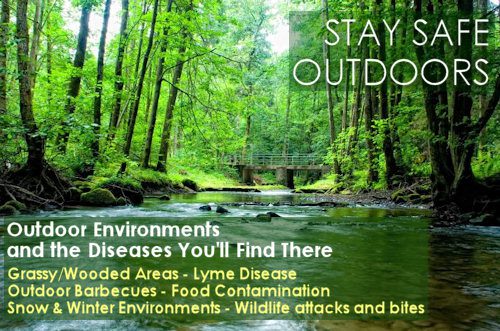3 Outdoor Environments and the Diseases You’ll Find There
Outdoor activities like camping, hiking, or even barbecuing in your backyard is fun, but they do bring the chance of disease, insect bites, and other outdoor environmental dangers. Before you venture to one of these three outside environments, know what to expect.

Grassy/Wooded Areas
There may be nothing finer than hiking or camping in wooded and grassy areas full of nature’s beauty. Lyme disease, however, is a definite concern. The American Lyme Disease Foundation offers a map on where Lyme disease is most prevalent in the U.S. Although many think this disease is only a danger in the Northeast, it is also prevalent all the way up and down the east coast, in the Midwest, some southern states including Texas, and up and down the west coast.
Lyme disease is an infection caused by a deer tick bite. The infection, borrelia burgdorferi, is a type of bacterium known as a spirochete. If an infected tick bites you, the disease is easily transmitted and then travels through the bloodstream. Some of the common symptoms include:
- Rash, especially around the bitten area
- Flu-like symptoms including chills, fatigue, fever, and body aches
- Joint pain, especially for people who don’t seek out urgent care.
- Neurological problems, also for people who don’t seek out retail clnics that offer emergency treatment for tick bites and Lyme disease.
People who are bitten and receive no treatment may develop some or all of the above symptoms and if not treated, may also suffer from:
- Eye inflammation
- Hepatitis
- Excessive fatigue and tiredness
Before outdoor activities where deer ticks are present, perform a Google search on “urgent care near me,” in the event you are bitten. Treatment includes removing the tick if it is still present, and oral antibiotics. Untreated, Lyme disease can last for years or the duration of a lifetime. Often, cases treated long after the deer tick bite require IV antibiotics. Always use a DEET insect repellent during these outings.
Outdoor Barbecues
Cooking on the grill is a favorite, and depending on where you live, can be enjoyed year-round. When heading out to barbecue, however, be sure you use common sense when it comes to handling and cooking foods outdoors to avoid:
- Food cross contamination – Clean foods and place them on different plates or trays. Use a clean platter once the food is cooked.
- Cook foods thoroughly – All meat, fish and poultry needs to be cooked thoroughly to avoid the spread of e-coli and other bacteria. FoodSafe.gov offers a chart on how long foods should be cooked depending on type.
- Keep hot foods hot and cold foods cold. Do this with coolers and heating trays to avoid food poisoning.
If you do experience symptoms of nausea, vomiting, diarrhea or intestinal upsets and fear you may have been affected by grilled food, seek out a walk-in clinic for immediate medical care.
Snow & Winter Environments
Skiing, snowmobiling, and snowshoeing are popular activities in the winter in many areas in the U.S. It’s important follow the rules and regulations for private, state, and national parks to prevent falls in restricted areas or wildlife encounters that may result in an attack or bite. If you are bitten by a wild animal know the urgent care locations near you so you can seek out medical care as quickly as possible.
Accidental falls can cause cuts, bruising, and lacerations and may require stitches or wound treatment. Again, it’s best to know walk-in clinic locations so medical aid is achieved quickly.
If you prepare ahead of time and use commons sense, you will enjoy these three outdoor environments and lower your chances of emergency medical treatment.
About the Author
Jacob Anderson is a freelance journalist from Scottsdale, Arizona who writes for a variety of health and wellness blogs and periodicals.


